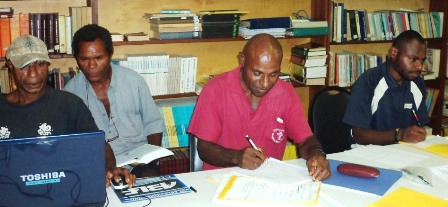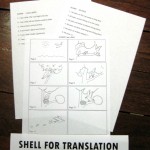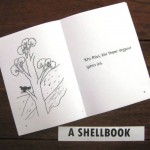By Diane Miller
 The two Akukem Bible translators on the left in the above picture and the two literacy worker on the right speak the Akukem language. They and one other literacy worker recently spent some time working in our Office in Madang. The literacy workers completed shellbooks containing 20 different stories for their Elementary Prep schools and worked on about 20 other titles which are now in various stages of completion. Caspar (grey shirt) doubled as a literacy worker and translator, joining the literacy team until Leo could get to town and then continuing to check printed stories in between translation tasks. Two of the men who came drew pictures for original stories being produced in a manner similar to shellbooks. As a part of promoting literacy throughout Papua New Guinea, Pioneer Bible Translators (PBT) produces hundreds of shellbooks , but just what is a shellbook and how is it produced?
The two Akukem Bible translators on the left in the above picture and the two literacy worker on the right speak the Akukem language. They and one other literacy worker recently spent some time working in our Office in Madang. The literacy workers completed shellbooks containing 20 different stories for their Elementary Prep schools and worked on about 20 other titles which are now in various stages of completion. Caspar (grey shirt) doubled as a literacy worker and translator, joining the literacy team until Leo could get to town and then continuing to check printed stories in between translation tasks. Two of the men who came drew pictures for original stories being produced in a manner similar to shellbooks. As a part of promoting literacy throughout Papua New Guinea, Pioneer Bible Translators (PBT) produces hundreds of shellbooks , but just what is a shellbook and how is it produced?
Our computer files include templates for books contributed by other mission groups, by the Papua New Guinea (PNG) Department of Education and by various individuals as well as by PBT personnel. The booklets in the templates have pictures but no words—just shells of books—but we alsohave files with English and Pidgin versions of the stories  represented by the pictures. To produce a shellbook in a certain language we give speakers of that language a printed copy of the pictures and text for the book which we call a “shell for translation’ and ask them to translate the story into their language. Once translated into the desired language, the story is then typed into a computer and saved as a file. The printed file goes back to the those who translated it or to another speaker of the same language to be checked. After corrections are marked and entered into the computer, this process is repeated again and again until there are very few or no corrections. At this point the text is copied into the book template or shell. The checking and correcting process resumes and continues until the book is finally deemed finished and a final copy can be printed.
represented by the pictures. To produce a shellbook in a certain language we give speakers of that language a printed copy of the pictures and text for the book which we call a “shell for translation’ and ask them to translate the story into their language. Once translated into the desired language, the story is then typed into a computer and saved as a file. The printed file goes back to the those who translated it or to another speaker of the same language to be checked. After corrections are marked and entered into the computer, this process is repeated again and again until there are very few or no corrections. At this point the text is copied into the book template or shell. The checking and correcting process resumes and continues until the book is finally deemed finished and a final copy can be printed.
 The process for creating books with original stories is similar, but someone must first write a simple story designed for a specific literacy use such as school curriculum, adult literacy classes, or building of libraries. Someone must draw pictures to accompany the story and then both the pictures and story can be entered into the computer. Only after several checking sessions is the book ready to be printed and used. Having these templates or shells for producing books makes it relatively easy to provide reading material in a variety of languages for the people in those language groups who wish to learn to read. We have shells of Biblical stories as well as other stories and we pray that all of these shellbooks will be used to build reading skills which will enable people to read and understand the Word of God in their heart languages.
The process for creating books with original stories is similar, but someone must first write a simple story designed for a specific literacy use such as school curriculum, adult literacy classes, or building of libraries. Someone must draw pictures to accompany the story and then both the pictures and story can be entered into the computer. Only after several checking sessions is the book ready to be printed and used. Having these templates or shells for producing books makes it relatively easy to provide reading material in a variety of languages for the people in those language groups who wish to learn to read. We have shells of Biblical stories as well as other stories and we pray that all of these shellbooks will be used to build reading skills which will enable people to read and understand the Word of God in their heart languages.
Diane serves through the ministry of developing curriculum and literacy material.